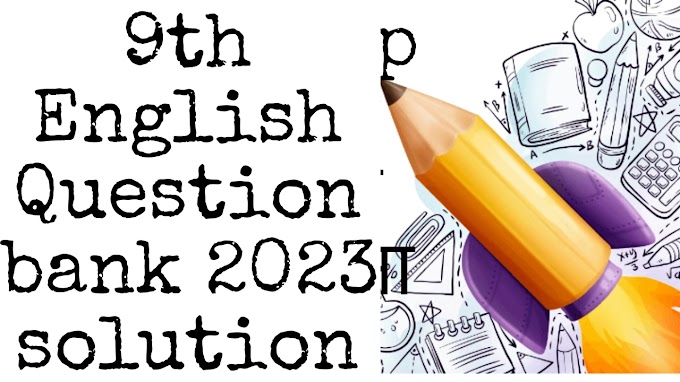MP Board class 11th english varshik pariksha paper solution 2022,11th english annual exam imp questions
11th English varshik pariksha question paper 2022- Hello friends, all of you are welcome in our website and in today's post I will tell you about MP board 11th english Anuual examinations.Everyone's question paper and Their solution will be found.MP board 9th,11th varshik paper has been starded shortly 16th march 2022.MP board has been announced the final datesheet of class 9th and 11th.so we provide the most importaion questions of class 9th,11th all subjects in both mediuam hindi and english
How to download MP board Class 11th english question paper
All of you can download the MP board 9th question paper 2022 the official website or you can also download through our website through the link given below
How to download MP board 11th english question paper solution pdf
All of you can download the MP board 9th class question paper solution through the official website or you can also download through our website through the link given below
MP BOARD 11th class question paper 2022
| Board | MP BOARD |
| Class | 9th,11th |
| subjects | All subjects |
| MP board class 9th,11th exam date | 16 march 2022 |
| MP board class 9th,11th End date | 12 april 2022 |
| Exam mode | offline |
| official website | mpbse.nic.in |
MP Board 11th question paper 2022
11th Hindi varshik paper 2022
11th English varshik paper 2022
 |
| 11th english varshik pariksha paper solution |
कक्षा 11 वीं परीक्षा अंग्रेज़ी
[Total No. of Questions: 15]
[Total No. of Printed Pages: 16]
[Time: 03 Hours)
[Maximum Marks: 100].
Instructions
(1) All questions are compulsory.
(2) Marks are indicated against each question.
Q.1
SECTION - A
Read the following passage and answer the questions on the [10x1=10]
basis of comprehension of the passage (Any ten).
Ideas rule the world and thoughts decide the way of life. It is the mind which sculptures one's destiny. If one thinks positively, if one thinks in the right direction, one achieves the goal, what one
aspires for. Ideas are nothing, but an outcome of one's detailed thinking. They shape and determine the destiny of human beings and contribute to the growth and well-being of the civilization.
Every great achievement whether in the field of religion, science, medicine, space, technology, information and communication sector or in any field, was at the first stage, an idea. The most
extraordinary success, the astonishing scientific discovery, the splendid technological feats like splitting the atom, heart
transplantation , cloning of sheep , unraveling the secrets of Mars, walking on the surface of the Moon, were all the results of an idea in the beginning. Have we ever thought of the present revolution in Information Technology two decades back? It was
the vision of Azim Hashmi Premji, N.R. Narayan Murthy and also the late Dewang Mehta, Sam Pitrala and others who catapulted India among the super powers in IT sector. Ideas with knowledge,
lead to action and success comes to you with hugging hands. Knowledge is power. When a person applies his knowledge and understands the problem, analyses the prevailing situation with
hard work and perseverance, the solution is not far to reach and when one knows the answer, the success is yours. It was the
noble idea of Alfred Nobel, inventor of Dynamite, to use his fortune. for the establishment of Annual awards to people who contributed outstandingly in the field of Physics, Chemistry, Medicine,
Literature, Economics and Peace.
"Ideas are like rabbits, you get a couple, learn how to handle them
and pretty soon you have a dozen."
- John Steinbeck
Questions -
(0) How can we solve a problem?
(ii) India has become a super power in IT sector. To whom does
the credit go?
(ii) How can a person achieve his goal?
(iv) Why has John Steinbeck compared ideas with rabbits?
(v) What is 'a period of ten years' called?
(vi) Mention some scientific and technological advancements of
human civilization.
Q.2
(8x1=8]
(vii) You must have heard about Nobel Prize. In how many fields
is it given? Mention them.
(vi) What does not lead to success?
(a) analysis
(b) knowledge
(c) prejudices
(d) perseverance
(ix) Pick out a word from the passage which means 'magnificent'.
(x) What is the adjective form of fortune'?
(xi) What is the opposite of 'decline"?
Read the passage and answer the questions (Any eight) -
Literacy is one of the most essential indicators of the quality of a country's human capital. While the country has made significant progress in improving literacy over the years, it continues to be home to 313 million illiterate people; 59 percent of them are women. About three decades ago, the adult male literacy rate in India was almost twice that for adult females. While this gap has narrowed substantially over the years, adult male literacy rate still surpasses the adult female literacy rate. A survey was conducted by National Observer Research Foundation, New Delhi, India. The collected information is given below -
Year
1987 1993 1999 2007 2014 2017
(%) (%) (%) (%) (%)
(%)
Male Literacy Rate 60.5 65.5 69.2 76.6 80.3 81.5
Female Literacy Rate 31.7 37.9 43.8 54.9 61.8 64.6
Gender Gap in 28.9 27.6 25.4 21.7 18.5 16.9
Literacy
Questions -
(i) What was the male literacy rate in the year 1987?
(ii) What was the female literacy rate in the year 1999?
(iii) Which one was greater – female literacy rate in 2014 or male
literacy rate in 1987?
(iv) How much was the gender gap in the literacy rate in the year
1993?
(V) In which year was the male literacy rate at the highest?
(vi) in which year the gender gap in literacy was 21.7%?
(vii) In which year did the female literacy rate show the highest
boom/rise?
(viii) In which year was the gender gap in literacy at the highest?
(ix) What do you find after analysing the data – The Gender Gap
in Literacy is increasing or decreasing?
Read the passage carefully and make notes. Supply a suitable [5+3=8]
title and write a short summary on the basis of your notes (in your
own words)
Disaster management is a term that is usually referred to as the
management of resources and responsibilities in dealing with the
losses of life and property in a disaster. Every country should have
a plan to maintain or mitigate the cause of disasters. The whole
world is in the disaster management mode due to the COVID - 19
pandemic that has gripped the whole world. Countries that were
disaster - ready are coping up with the pandemic relatively well
than the countries that had neglected the importance of disaster
management. The example of U.S.A., Italy or Spain is in front of
us. Disasters can be both, man-made as well as natural.
Q.3
Earthquakes, floods, volcanic eruptions, landslides etc. are some natural disasters. Bomb explosions, gas leakage, fire accidents, wars etc. are some man-made disasters. Disaster management should always have long term planning and everything should be in place well before the occurrence of disasters. Organizations such as the National Disaster Management Authority (NDMA) takes necessary actions during and before disasters. When the cyclone Amphan hit India and Bangladesh on the Bay of Bengal coast, the preparedness of the authorities led to the mass evacuation of people in the red zones. A proper rehabilitation program should be in place to help the victims. Government should provide them employment opportunities, health and monetary aids etc. Citizens can also play a significant role in disaster management. They can spread awareness about the precautions to be taken. It is the duty of the teachers and school-management to let the students understand their duties and responsibilities during and after the disasters. People should have the knowledge of basic first aid. They should be trained not to panic and to avoid spreading rumours, hoaxes and false news.






